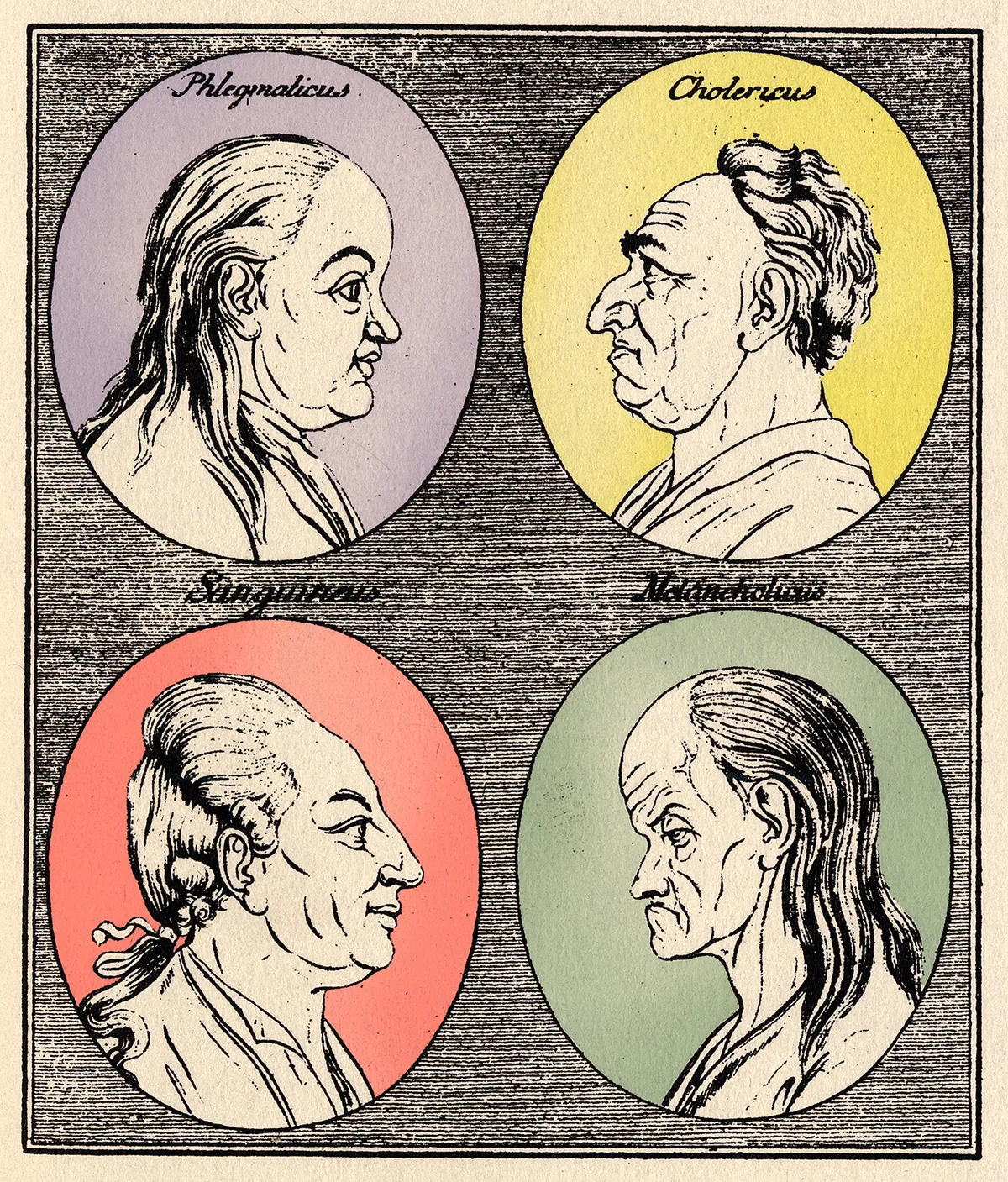How fitting that the sociable composer Carl Nielsen should find inspiration for his Second Symphony in a country pub while having a beer with his wife and friends.
What inspired Nielsen to compose his second symphony?
There he spotted a naive, brightly coloured painting depicting the Four Temperaments – characters based on the medieval theory of humours that regulate the human body.
Nielsen laughed out loud at the comic, exaggerated figures representing the Choleric, the Phlegmatic, the Melancholic and the Sanguine man, yet couldn’t get them out of his mind. ‘These simple paintings contained a core of goodness and – even – a musical possibility into the bargain,’ he recalled some 30 years later.

Nielsen had always been fascinated by psychology, and his letters contain perceptive portraits of musicians he encountered. In the Second Symphony he aimed to translate human complexity into music, perhaps recognising the contradictions evident in his own volatile character.
A sequence of photographs from 1887 (in the Royal Library Copenhagen) show Nielsen fooling around for the camera: his pleasant features, tufty blond hair and large blue eyes suggest an easy-going and playful young man. In fact, his life and relationships were often fraught with difficulty and he suffered from periods of depression.
When did Nielsen compose his second symphony?
Nielsen wrote his Second Symphony in 1901, while employed as a second violinist in the Chapel Royal Orchestra (later the Royal Danish Orchestra).
In November 1902, he conducted the premiere of his first opera at the Royal Theatre and three days later conducted the first performance of his Second Symphony for the Danish Concert Association. It was well received by the audience, but the reviews were mixed.
Danish composer and critic Leopold Rosenfeld called it ‘a suite of moods for orchestra’ rather than a symphony. ‘What is especially captivating about these musical illustrations is the composer’s ability to mix colours, which neglects no opportunity to exercise the listening ear. Sometimes, though, the colours are very brutal and in their crudeness easily cross the aesthetic line.’
Later audiences would be enchanted by the ideas that mark Nielsen out as an original, experimental and bold composer. Those qualities were already evident in his First Symphony of 1892, his unorthodox juggling of keys anchored by an instinctive feeling for counterpoint and melody.
He developed these more successfully in the Second Symphony, which though it may not rival the Third Symphony (‘Espansiva’) in popularity, nevertheless has many of the same ingredients. Nielsen knows how to lift the heart with those joyful high woodwind passages, while his earthy bassoon and trombone lines add colour and depth to his canvas. He has a gift for depicting life in all its mess and beauty, and nowhere more so than in ‘The Four Temperaments’.
A guide to the music of Nielsen's Symphony No. 2, ‘The Four Temperaments'
In chatty programme notes for a Stockholm performance in 1931, Nielsen gives insights into his vision for each movement. Though not a fan of programme music, he nevertheless imagined the movements as the characters portrayed in those garish paintings: choleric, phlegmatic, melancholic and sanguine.
Noting that every person has elements of each temperament, Nielsen shares motifs and melodies between movements – for instance, one of his favourite intervals, the rising minor third, appears in both the Phlegmatic’s lilting melody and the Melancholic’s tragic opening theme.
The first movement, Allegro collerico, starts ‘impetuously’ as Nielsen writes, with short emphatic chords leading into a headlong gallop down the scale and up again, dynamics lurching from f to fpp to fz. That choleric horseman is unable to rein in his anger until the second, lyrical subject, but then something rouses him again and the music reflects this intemperance. With its rhythmic variety and mood swings, the exposition has a picaresque flavour, recalling something of Berlioz’s lively orchestral adventures.
For the second movement, Allegro comodo e flemmatico, Nielsen imagines an indolent, lovable youth lounging beside the harbour ‘with his legs dangling over the edge’. The influence of his rural childhood permeates this heady, summer-filled reverie, with a single sudden forte. ‘Did a barrel fall into the water and disturb the young man for a moment?’ asks Nielsen. ‘Maybe. So what.’
In the Andante malincolico, Nielsen aims to express the character of a heavy, melancholic man. Broad, solemn melodies stir the heart, never descending into sentimentality – but a shadow of anxiety lurks beneath. Nielsen remarks ruefully, ‘What the composer himself wants has less significance than what the music’s innermost essence is searching for.’
And the Allegro sanguineo? ‘A man who storms thoughtlessly forward in the belief that the whole world belongs to him, that fried pigeons will fly into his mouth without work or bother,’ as Nielsen remarks. Indeed the music bursts rudely onto the scene, followed by a joyous, galumphing hoe-down when the musicians throw caution to the winds and join the party. A cheerful, cocky coda – Marziale – ends this exhilarating work.
The best recordings of Nielsen's Symphony No. 2, ‘The Four Temperaments'
Ole Schmidt (conductor)
London Symphony Orchestra
Alto ALC2505
Two superb performances – Herbert Blomstedt and the San Francisco Symphony from 1989 and a brand-new release from the Danish National Symphony Orchestra and Fabio Luisi – burnish Nielsen’s exhilarating score with their power and polish. But it’s the nearly 50-year-old performance by Ole Schmidt and the LSO that, in spite of its shortcomings, best captures Nielsen’s character studies with irrepressible vigour and humanity.
Their pioneering complete symphony cycle was recorded between power cuts during the three-day week in London in 1974, giving the performances an urgency that more pampered recordings lack. The string sound is sometimes thin and ragged and the brass can be too prominent, but the overall impression is of an orchestra thrilled to be discovering this music with a Danish conductor steeped in Nielsen. Originally on Unicorn Kanchana, it’s been remastered and reissued by Alto, with improvements in balance and clarity.
From the first outburst of the Allegro collerico, the contrast between rage and reflective moments is well drawn. Savage strings tear into the runs, brass and woodwind bray in sharp two-note figures. When the second theme arrives, Schmidt broadens the tempo till the melody floats like a great ship on the swell. In the Allegro comodo e flemmatico the orchestra conjures up a lazy summer day on Funen; over the lilting breeze you can hear a fly buzzing, a detail not obvious in all recordings.
The opening tempo of the Andante malincolico is the litmus test for any conductor. Luisi and the Danish NSO fall down here – their funereal plod strips the melody of its momentum – but Schmidt maintains a measured pace, nothing exaggerated or sentimental in his melancholy. Pungent brass and woodwind exclamations before the poco largamente contrast with the fairy-tale second theme, un pochettino più mosso, all veiled strings and delicate woodwind lines – even in 1974 the LSO clearly had top-rank soloists.
Schmidt’s high-wire performance of the Allegro sanguineo really sets the pulse racing. In this hectic hoedown the strings almost trip over their own shoelaces and the brass and horns galumph along like village bandsmen, a flashback to the 14-year-old Nielsen playing trumpet in a military band. And the triumphant Marziale coda, despite its abrupt, unsophisticated ending, is dispatched with irresistibly life-affirming confidence.
Herbert Blomstedt (conductor)
Decca 430 2802
If you can’t live with imperfections, choose the masterly performance of Herbert Blomstedt and the San Francisco Symphony, recorded in 1989. It’s never seat-of-the-pants exciting like Schmidt, but there are heady moments, such as the end of the first movement, when the whole orchestra hurls itself towards the precipice.
Some unbuttoning of the brass would have been nice in the last movement – horns should not be well-behaved! – but Blomstedt’s control of dynamics is admirable, the orchestral balance is superb and the recording quality second to none.
Fabio Luisi (conductor)
Deutsche Grammophon 486 3481
The Danish National Symphony Orchestra performs its countryman’s music with a special authenticity, and under Italian conductor Fabio Luisi in this new recording the playing is fabulous. The second movement is the highlight – honeyed horns and woodwind, plus dark, soothing strings lulling the listener into slumber. So romantic – and not very Nielsen. Luisi starts to wallow in the Andante melancolico, luxuriating in the string progressions and those mighty horns and losing the melodic arc in the process. But if you love a big, bold orchestra with Nielsen in its blood, this is the one.
Sakari Oramo (conductor)
BIS BIS2128
A very enjoyable journey from 2014, with a confident conductor and the first-class Royal Stockholm Philharmonic Orchestra. Transparent textures make even the densely written passages clear, contrasting and colourful. There’s plenty of fury and fire in the choleric passages, but a slightly 19th-century nostalgic mood in the third movement. It makes Nielsen sound conventional and irons out his delightful inconsistencies where a little jerkiness might be more invigorating. Compared with Schmidt and the LSO it’s gorgeously polished… but a bit too well-mannered.
And one to avoid…
Surprisingly, this recording which looks so good on paper – the esteemed Finnish conductor Paavo Berglund and Nielsen’s own orchestra – turns out to be a dud. Fabio Luisi shows how a non-Dane can fire up a Danish ensemble, just as Schmidt imbues his London orchestra with his own Danish spirit. Under the septuagenarian Berglund, however, the Royal Danish Orchestra in 1987-9 sounds cautious, tentative and, alas, downright dull.

